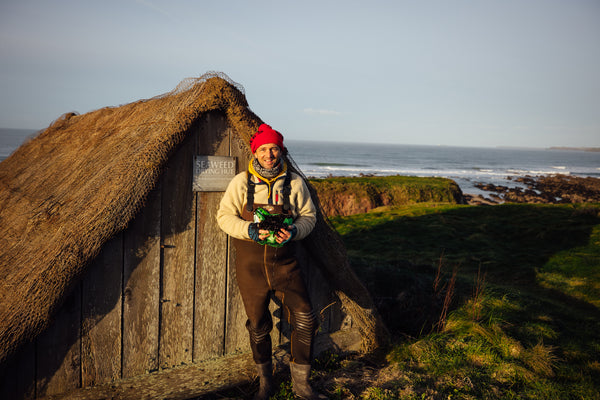THE SHOP IS CURRENTLY CLOSED FOR THE SUMMER. PLEASE SIGN UP FOR MORE INFO.
THE SHOP IS CURRENTLY CLOSED FOR THE SUMMER. PLEASE SIGN UP FOR MORE INFO.
THE SHOP IS CURRENTLY CLOSED FOR THE SUMMER. PLEASE SIGN UP FOR MORE INFO.

In a nutshell it adds an extra depth of flavour to everything you put seaweed into, whether that is the bacon roll or a beach brownie. And though you cannot always taste the seaweed distinctively it is there, the very backbone of the Café Mȏr flavour powerhouse and everything we do with our artisan Deli products.
Seaweed is at the very core of what we do at Café Mȏr, it is in everything and people are super intrigued, so here's a little information for you:
We don’t use all 1000 species of seaweed in our cooking, most seaweeds are really small and very difficult to harvest. There is one poisonous seaweed called “Desmarestia”. This seaweed contains sulphuric acid and will give you a very painful stomach if consumed. Thankfully, it only grows in deep water and very rarely found on the shore.
LAVER SEAWEED:
To make Laver seaweed into Laverbread, you have to boil laver seaweed for up to 7 hours with a little salt and then blend it to make a greeny black puree, that is it. The name is confusing as it is not actually a bread.
The name comes from how they used to process laver seaweed before the days of blenders and mincers. The traditional way was to break it down and kneed it like you would with wheat to make bread. Laver is only one cell thick but is surprisingly tough and requires this processing to make it palatable.
Laver is a similar species to Nori which is used in Japan and around the world to make sushi.
The Taste
Laver seaweed has a high iodine content that gives it a distinctive marine olive flavour, it is not always a food you will fall in love with straight away - it’s a grower. You need time to take it all in, trust me!
To me Laverbread (bara lawr) has to be one of the food wonders of the world, (note that I am Welsh and so completely biased):
1. It is only found in Wales.
2. It is harvested from rocks in the wilds of West Wales which have the second largest tidal range in the world and takes the full force of the Atlantic storms.
3. Not many other foods take 10 hrs to cook.
4. No other food looks so unappealing after 10 hours of cooking.
5. It is a powerhouse of nutrients, vitamins and minerals and is completely at odds to the typical meals consumed by the Welsh public in the 21st century.
6. Its versatility is only being discovered now in modern day cooking.
7. It tastes sublime.
Sign up to our newsletter or follow us on social media for tasty seaweed recipes, new product and stock updates, plus news of what we are up to down here in Pembrokeshire.
We will never pass on your email address or social account to third parties and you can unsubscribe at any time.

Due to changes at The Pembrokeshire Beach Food Company, the online shop will be closed for the summer from 22nd April 2024. We apologise for any inconvenience caused. Please sign up to our newsletter for information regarding reopening.
Some products will be available to buy at The Old Point House, Angle, but we advise you call before travelling to check stock is available.